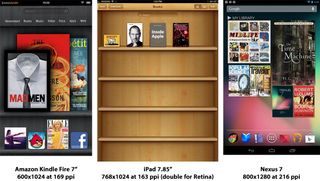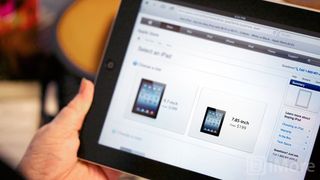Rumors of a smaller iPad have persisted for years, probably ever since Apple announced the original 9.7-inch iPad back in 2010, and definitely since competitors from Samsung to BlackBerry to Amazon to Google have shipped 7-inch tablets. Apple has been experimenting with smaller form factor tablet for while, perhaps as far back as the original Safari pad project that ultimately yielded the iPhone in 2007, and certainly since Apple SVP Eddy Cue helped warm Apple's late co-founder, Steve Jobs to the idea back in 2011.
Back in March of 2012, iMore learned that Apple had decided to go ahead with the iPad mini, that it would be running the iPad version of iOS, that it would cost around $200-$250, and that it was tentatively planned for an October 2012 release. Back in July, we learned Apple was planning to announce the iPad mini on September 12. Now, however, it looks like October was and is indeed the month of the iPad mini, and we might even have a rough idea what the iPad mini is probably going to look like.
Despite all this, despite a few parts leaks and some information about the new, miniaturized Dock connector, there's still a lot we don't know -- like what Apple will ultimate call it. But whether it's the iPad mini or the iPad Air, the 7- or 8-inch iPad, or something else entirely, there's a lot we've tried to think through and put some context to. Here's a quick roundup of what we've put together so far.
What the iPad mini will probably look like

Looking at it, the iPad mini may not seem radically smaller than the 9.7-inch iPad. And that's the point. It's not supposed to be a major compromise in screen size or usability. It is, however, thinner and lighter enough to make a substantial difference. Holding it with one hand will be easier, and holding it for prolonged periods of time will be much easier.
It's those two elements, the lightness at that size, that allows for the smaller bezel -- just like the iPod touch's thinness and lightness allows for an even smaller bezel still. (Obviously the top and bottom bezel aren't as radically thin, due to the components that need to be placed there, like the Home button.)
Most importantly, this isn't a big iPod touch. This is a small iPad. Here's why that makes such a difference:
Why Apple would release an iPad mini

Apple's goal is to mainstream computing. They want to sell hundreds of millions of devices that delight exactly the type of consumer usually left frustrated and alienated by technology.
While neither the 7 inch BlackBerry PlayBook, nor the 7 inch Amazon Kindle Fire, nor the 7 inch Google Nexus 7 have taken the world by storm, they aren't iPads. They didn't focus on a simple, consumer-friendly interfaces, tablet-specific apps, and content that was accessible beyond U.S. borders.
Even considering the current iPad's incredible market lead, some customers may simply not be buying it because it's too heavy or too expensive. With an iPad mini, Apple can remove those barriers of entry, and more:
How Apple could implement the iPad mini interface

The iOS interface, as it's running on the current iPad, would simply run scaled down on the 7.x-inch iPad. Pixel count would be the same as the 9.7-inch iPad -- 1024x768. (Getting 2048x1536 down to 7.x-inches for around $200 may not be doable until future generations.) Pixel density would be around the same as the original 3.5-inch iPhone, 163 ppi. (Or 326, the same as the iPhone 4 and iPhone 4S, if and when it goes Retina.)
Everything would then simply stay the same. Buttons and touch targets would be smaller, but not unusably so. The "slack" that currently exists between 3.5-inch iPhone interface elements and 9.7-inch iPad elements would just disappear, and you'd have the same basic iPad look with the same basic iPhone usability. Here's how it would work:
How Apple could handle the 7-inch iPad mini display

On one hand, it's hard to imagine Apple releasing a non-Retina iOS device at this point. The current generation iPhone, iPod touch, and iPad are all running at Retina resolutions. On the other hand, no iOS device has ever been introduced with a Retina display. The original iPhone, iPod touch, and iPad were all launched with standard displays, and later received Retina displays as part of their upgrade cycles.
Rumor has it, Apple experimented with a Retina display in the 2011 iPad 2 but due to price and yield issues, had to wait until the 2012 iPad to ship it. Arguably, 2048x1536 is right at the edge of what the 9.7-inch iPad can handle, and it might take until 2013 and new chipsets before it gets really comfortable. Likewise, it's possible Apple has experimented with a Retina display for the iPad mini but not for the one that's rumored to be shipping this year. Still, there are several options:
What Apple could call the 7-inch iPad

Internally, for now, Apple might still be calling it "the 7-inch iPad" and be leaving the big branding decisions for closer to launch time. Or maybe they've already decided to call it an "iPad mini" and "iPad Air" or something else. Either way, whatever name they choose will influence how the public understand the new device and its place in Apple's lineup.
Apple's branding is typically as succinct as Occam's Razor. Earlier this year, they took it a step further and rebranded what would have been the iPad 3 as simply the (new) iPad. While we probably won't see Phil Schiller on stage beneath a slide reading "the small iPad", we probably will see him beneath one reading something similarly simple. Here are the possibilities:
- The name game: What Apple could call the 7-inch iPad
Could Apple sell a $200 iPad mini?

Apple has a long history of successfully marketing multiple sizes. Just look at the MacBook Pro and Macbook Air lines. You have 11-, 13-, and 15-inches options (and until a couple of months ago, 17-inches as well). Tablets could just as easily come in multiple sizes. Once you pick an aspect ratio (whether it be 16:9 or 4:3, or something else), the size should just be an option.
If the entry level iPod touch stays at $200 and the iPad 2 stays at $400, where would the iPad mini fit in?
- Could Apple sell a $200 iPad mini?
More on the iPad mini
For more on the iPad mini, iPad air, or whatever Apple ends up calling it, check out:
- iPad mini
- iPad mini forum
Also check out John Gruber's deep dive:

Rene Ritchie is one of the most respected Apple analysts in the business, reaching a combined audience of over 40 million readers a month. His YouTube channel, Vector, has over 90 thousand subscribers and 14 million views and his podcasts, including Debug, have been downloaded over 20 million times. He also regularly co-hosts MacBreak Weekly for the TWiT network and co-hosted CES Live! and Talk Mobile. Based in Montreal, Rene is a former director of product marketing, web developer, and graphic designer. He's authored several books and appeared on numerous television and radio segments to discuss Apple and the technology industry. When not working, he likes to cook, grapple, and spend time with his friends and family.
Most Popular


